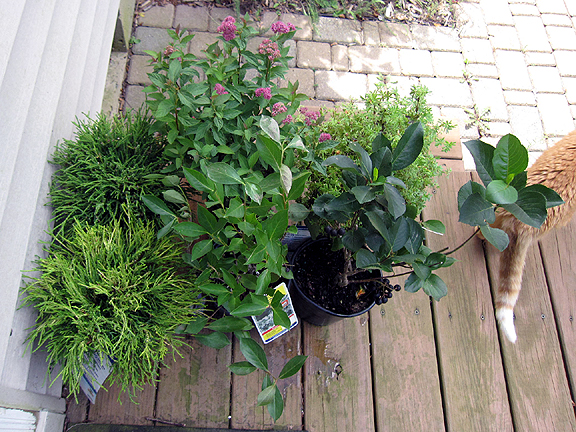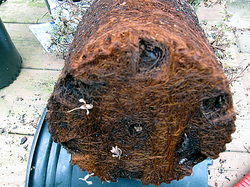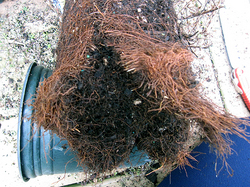10 tips for planting trees and shrubs in the fall
Fall is a great time to plant trees and shrubs. The soil is warmer now than in spring, and there's still time for roots to get established before the snow flies. Roots can grow in soil as cold as 40 degrees, and soil remains warm long after the air temperature drops. In southeastern Michigan, roots can grow though early December, but you need to plant trees and shrubs 6 to 8 weeks before then: now through mid-October.

Fall is a great time to plant trees and shrubs, and they're often on sale this time of year.
Monica Milla | Contributor
Here's how.
1. Read the information on the tag and pick a location that matches the growing conditions your plant requires. Note the plant's mature size and leave enough space around it to allow for air circulation and expansion to its full size. This is hugely important. You don't want to have to transplant a tree or shrub later (they're big!). You don't want its roots getting into your sewer system or it bumping into your house or over-shadowing other plants.
(If you're wondering how fast trees/shrubs grow, the easy answer is this: If you want it to get big fast, it'll be slow-growing. If you really want it to stay small, it will grow quickly.)
2. Move your tree or shrub to the intended location. If it's bulky or heavy, use a wheelbarrow to push, a tarp to drag, or a band of burly men to watch.
3. Dig the planting hole two to three times wider than, and just as deep as, the root ball. If you shovel the dug-out soil onto a tarp, it will be easier to refill the hole later. Once the hole is the right size, dig in the shovel a few times to loosen the bottom of the hole; this will make it easier for the roots to spread.
4. Remove all wires, twine, and plant tags. If the root ball is in burlap, you can remove it or keep it; it will decompose. Do cut it back from the top of the root ball, so it doesn't wick moisture away from the roots or stick out over the soil.

Sometimes trees and shrubs grown in pots will be root-bound.
Don't worry about cutting the roots; cutting encourages new roots to grow. In fall, plants naturally shut down for winter. The roots don't need to use their energy to supply nutrients or water to grow stems and new leaves; at this time of year, they focus on getting themselves established to anchor the plant and prepare for next spring.

If roots are tightly matted, cutting them, even crudely, does the trick.
6. Before lowering the tree or shrub into the planting hole, look at it (the tree or shrub, not the hole) from all sides and decide which side looks best. Orient the tree or shrub so that side faces out, and then lower the plant into the hole.
7. Make sure the top of the root ball is even with soil line. Shovel the soil you dug out earlier back into hole.
Do not amend the soil or add compost into the planting hole*. This is especially crucial for trees and larger shrubs. If the soil in the planting hole is much more nutrient-rich than the surrounding soil, the roots won't want to spread beyond it and will grow in circles instead of out like a web. This makes the plant much less stable. If you ever see small trees that lean at a severe angle or that topple over, that is likely why.
Adding compost as a top dressing is fine. It will work its way down.
Do not fertilize the tree or shrub. This is fall. We do not want to encourage foliage to grow; it will only weaken the plant and take energy away from root establishment. Fertilize in the spring.
Do not prune the tree or shrub. Pruning encourages new growth, which has the same detrimental effects in fall as fertilizer (above).
Adding a rooting hormone, which encourages only roots to grow, not foliage, is fine.
8. Press the soil down lightly, but do not stomp it down. You want air pockets so rain can get through, roots can grow, and worms can do their jobs.
9. Mulch around the planting hole. Two inches is plenty. You do not want to mound it up to look like a volcano. Keep the mulch from directly touching the trunk(s) or stem(s).
10. Water your newly planted tree or shrub 20 to 30 minutes a day until the ground freezes (generally early December). Trees and shrubs are thirsty, big drinkers. Not watering them in properly is a big mistake, especially in fall when they really need to establish roots in a short time.
Now sit back and relax, and enjoy your new tree or shrub for years to come. Maybe have a drink yourself.
* If you're a rose aficionado, you're probably going to disagree with me here. True, roses are heavy feeders and I'll let you slide in adding compost in spring planting, but not in fall. I know that if you're a serious rose fanatic, you're not going to listen to reason anyway (or you wouldn't be growing roses in the first place), so I know I'm wasting my breath. Fair enough!
Monica Milla, the Garden Faerie, is a master gardener volunteer, garden speaker, garden coach and author of "Fun with Winter Seed Sowing."


Comments
Cash
Wed, Sep 22, 2010 : 9:44 a.m.
Hi Mr Brown, I so agree. I have a gorgeous weeping crab apple I bought for $1 at the end of October many years ago. I could not imagine it's value today....well to me it's priceless.
Monica Milla
Tue, Sep 21, 2010 : 10:18 p.m.
Hi Katie though I think of you as Kathleen, lol, I admit I'm not a big plant waterer (except for veggies), full stop. Only when planting and transplanting. I rarely water trees or shrubs after the first year. I have about 40 shrubs and just can't manage it. Garden Faerie's Musings is very much a tough-love garden. Same goes for perennials. Lots of natives, everyone is tough. My one rose is an exception and I kind of rue having bought it. MBT, I guess if one wants a specific cultivar it may be sold out by fall (I got my rose in spring for example but that's an exception on so many levels).
Ramon
Tue, Sep 21, 2010 : 9:31 p.m.
Great tips Monica. I often wonder why people buy trees and shrubs in the spring when they're so cheap in the fall.
katie
Tue, Sep 21, 2010 : 7:33 p.m.
Thanks for the good tree planting tips, Monica. I'm also going to plant some smaller perennials, since I had good luck with fall planting for those last year. Also, the plant waterer sounds great. In the past I've let water trickle (about the size of a little finger) near the base of the tree. I've let it trickle for hours in dry weather to make sure that it goes slow and deep into the soil. This has worked very well, and it is telling that in dry weather when the grass is brown, there will be a green ring around the tree, even though I only put the hose in one spot and let it run very slowly. If you water deeply, you don't need to do it as often. I'm getting one of those deep root waterers right away!
Cash
Tue, Sep 21, 2010 : 2:28 p.m.
Hi Monica! Yes, that gadget is a lifesaver for me. I have grown many trees and never lost one...often buying them in late fall on final sales. I also use it during the hottest part of the summer for my "special" trees, Japanese maples and Katsura trees. They don't like the dry winds of summer. using it makes the roots go deep and that's a plus especially in a dry summer. I loved your article...thanks!
Monica Milla
Tue, Sep 21, 2010 : 2:13 p.m.
Hi Cash, Thanks for the handy tip. I admit I'm not a big "gadget" person but this waterer does sound inexpensive and handy. Since the soil is usually pretty loose from digging, I just lay the hose on the ground near the center of the tree/shrub, turn it on medium flow, and leave it laying there unattended for 20-30 minutes. (I have to set a timer or my water bill gets REALLY high.)
Cash
Tue, Sep 21, 2010 : 2:06 p.m.
If you are planting a tree at any time, I suggest investing in a cheap little "deep root waterer" that you just hook to your hose and it has a 20" or so metal piece that you insert into soil...and the water comes out of the bottom of that metal piece and deep waters the tree. Even if the ground is hard, the water pressure will loosen the soil and allow the metal piece to be pushed deep. This type of watering is most efficient and you don't need to stand and hold the hose, nor do you waste water spraying elsewhere. It's possible to stand with a hose and water for 20 mins in dry weather...and that water might not get down to the bottom of the root ball. And sprinkler watering is not sufficient for trees of any age, ever.